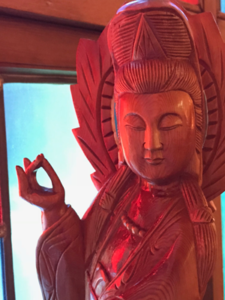 Zen meditation is the practice of seeing your own true nature – your Buddha nature. When the Buddha was dying, he told his disciples, “Don’t believe me, but find out for yourself whether what I have taught is true.” You can follow the path of Siddhartha Gautama and discover the same things that he did. But you can read all the books and listen to all the teachers in the world, but unless you begin your own practice, it is like a finger pointing at the moon – if you are always looking at the finger, you will never see the moon. So, you must develop a “just do it” mind and sit.
Zen meditation is the practice of seeing your own true nature – your Buddha nature. When the Buddha was dying, he told his disciples, “Don’t believe me, but find out for yourself whether what I have taught is true.” You can follow the path of Siddhartha Gautama and discover the same things that he did. But you can read all the books and listen to all the teachers in the world, but unless you begin your own practice, it is like a finger pointing at the moon – if you are always looking at the finger, you will never see the moon. So, you must develop a “just do it” mind and sit.
Commit to sitting every day – even if for only five minutes at a time. For a while, it may seem that five minutes is forever. Gradually you will find the ability to sit for longer periods of time. Find a quiet corner in your home that you can designate as a meditation space. Having some kind of altar helps to bring a sense of quiet to the space and will give direction to your practice. Lighting some incense or candles before sitting helps to settle the mind.
Sit with your back straight, but not stiff. You may sit in a half or full lotus, but if you are too stiff to do this a simple cross-legged position will do. Cradle your left hand inside your right hand, with the thumbs touching lightly as though you were gently holding a piece of paper between them. The hands should be held approximately 2 inches below your navel. This area is the “energy center,” and it is helpful during meditation to breathe down into this space. The eyes should be open and focused at a 30-degree angle in front of you. Make your mind very large and open.
There are different techniques to use for quieting the mind, and these are just a few suggestions. It is important to work with a teacher who can guide you in your meditation practice. You will find that your mind will often wander – daydreaming or remembering a past hurt or spacing out. It is important not to judge yourself when this happens. When you become aware that your mind has wandered, simply return to your meditation and begin again.
Counting the Breath
Count on each exhalation, from 1 to 10: inhale, exhale (“one”); inhale, exhale (“two”); etc. When you reach 10, begin at one again. If you lose track of the count, start over at 1.
A Great Question
This can be something like “Who am I?” or “What is this?” or “What is life?” Ask the question on the inhalation. On the exhalation, breath out “Don’t know!” very strongly.
Mantra Practice
Recite the mantra constantly, paying close attention to the mantra itself. Mantra practice is good when your mind is wandering a great deal. Some of the mantras used in our school are “Kwan Seum Bosal,” “Shin myo jang gu dae dharani,” or “Clear mind, clear mind, clear mind – don’t know.”
A steady home practice is important, but you should sit from time to time with a group. This serves as a reminder that you are not on this path alone. If you feel a strong connection to this practice, it is a good idea to become involved with a sangha, or community of practitioners, that is rooted in a tradition whose direction and teachings you agree with. Often, a sangha has a guiding teacher, who can answer questions and help you when you are having problems in your meditation.